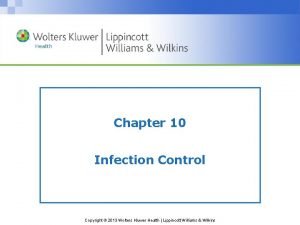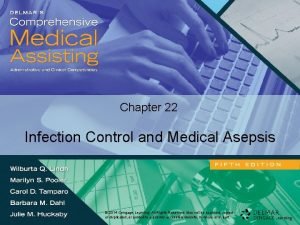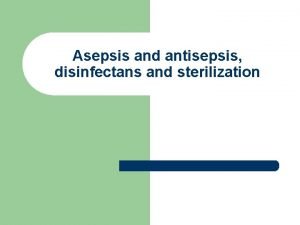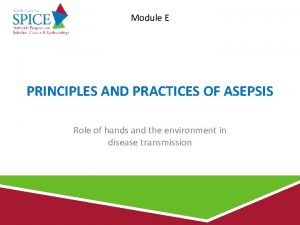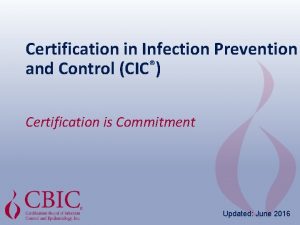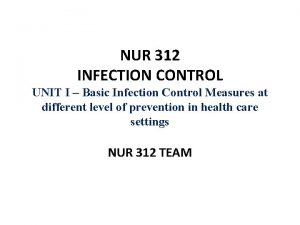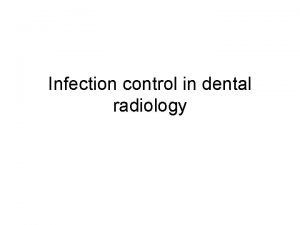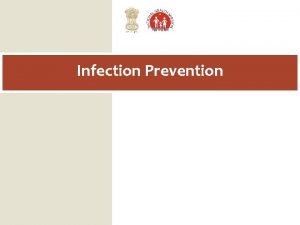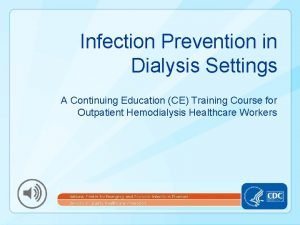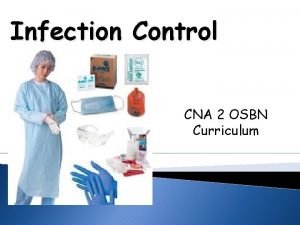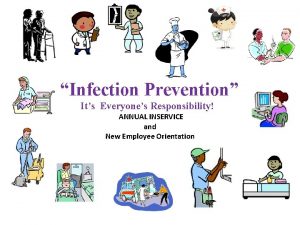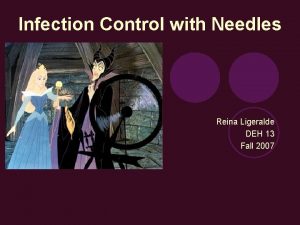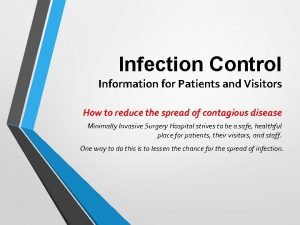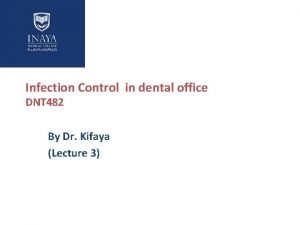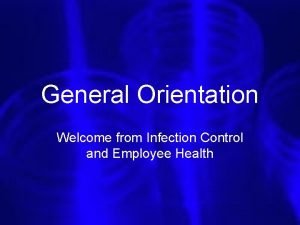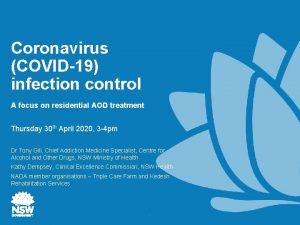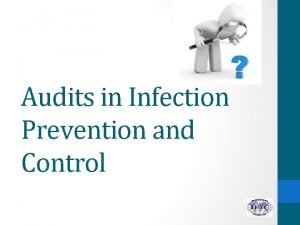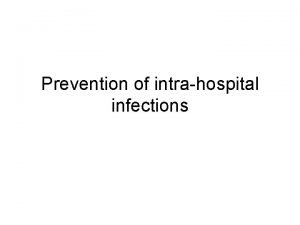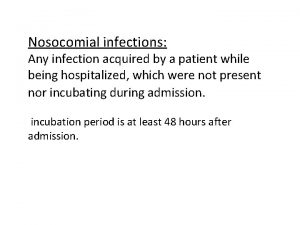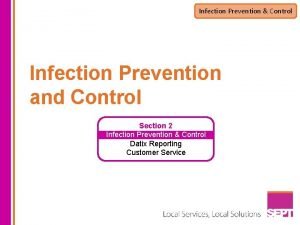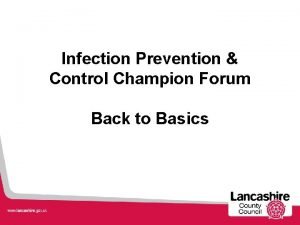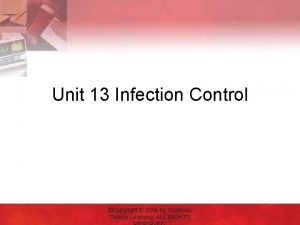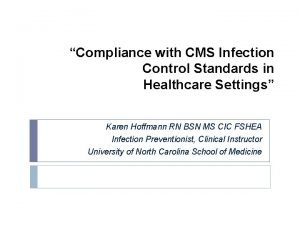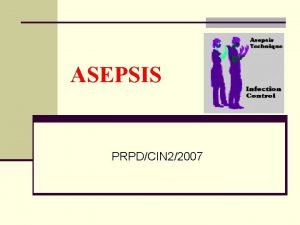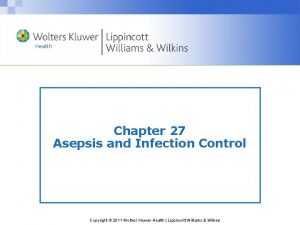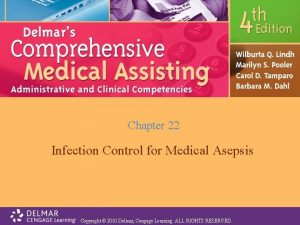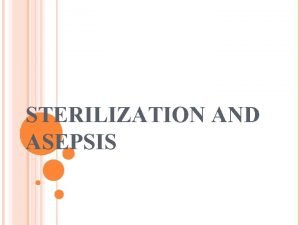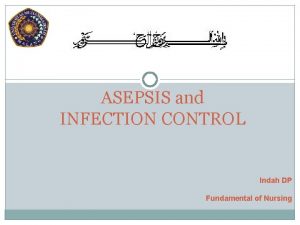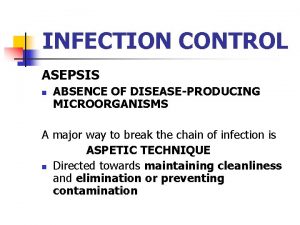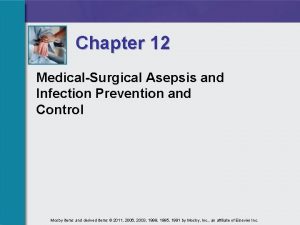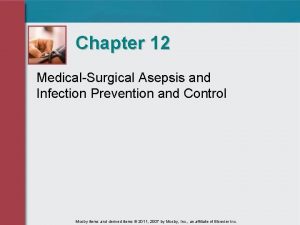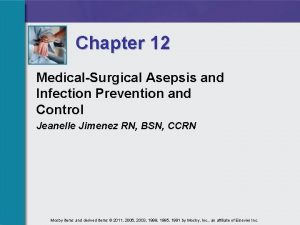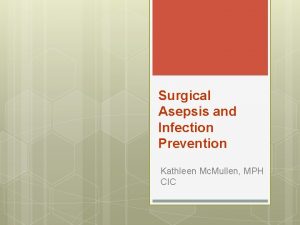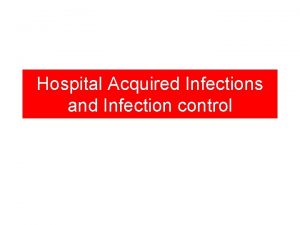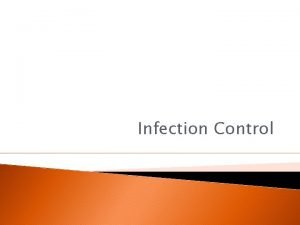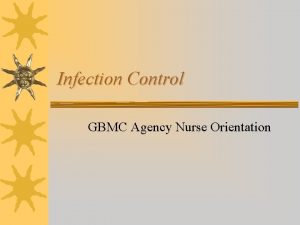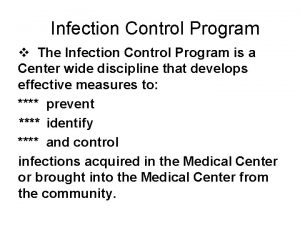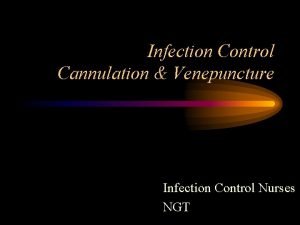Chapter 1 Asepsis and Infection Control Copyright 2011

































- Slides: 33

Chapter 1 Asepsis and Infection Control Copyright © 2011 Wolters Kluwer Health | Lippincott Williams & Wilkins

Infection Control Measures • Identifying the infection • Preventing infection – Breaking the chain of infection • Controlling infection – Minimizing complications – Reducing adverse outcomes • Teaching the patient about infection Copyright © 2015 Wolters Kluwer • All Rights Reserved

Practice of Asepsis • Medical asepsis (clean technique) – Involves procedures and practices that reduce the number and transfer of pathogens • For example, performing hand hygiene and wearing gloves • Surgical asepsis (sterile technique) – Includes practices used to render and keep objects and areas free from microorganisms • For example, inserting an indwelling urinary catheter or inserting an intravenous catheter Copyright © 2015 Wolters Kluwer • All Rights Reserved

Question For what patient care would the nurse use surgical asepsis? A. Administering medications B. Inserting an IV catheter C. Providing a bed bath D. Changing the linens on a bed Copyright © 2015 Wolters Kluwer • All Rights Reserved

Answer B. Inserting an IV catheter Rationale: Surgical asepsis, or sterile technique, includes practices used to render and keep objects and areas free from microorganisms. Procedures requiring surgical asepsis include inserting an indwelling urinary catheter or inserting an intravenous catheter. Medical asepsis, or clean technique, involves procedures and practices that reduce the number and transfer of pathogens, such as performing hand hygiene and wearing gloves. Copyright © 2015 Wolters Kluwer • All Rights Reserved

Skills to Assist in Preventing the Spread of Infection • Performing hand hygiene • Using personal protective equipment (PPE) • Preparing a sterile field • Adding sterile items to a sterile field • Putting on and removing sterile gloves Copyright © 2015 Wolters Kluwer • All Rights Reserved

Five Moments for Hand Hygiene (WHO, 2009) • Moment 1 – Before touching a patient • Moment 2 – Before a clean or aseptic procedure • Moment 3 – After body fluid exposure risk • Moment 4 – After touching a patient • Moment 5 – After touching patient surroundings Copyright © 2015 Wolters Kluwer • All Rights Reserved

Question Is the following statement true or false? It is not necessary to perform hand hygiene prior to performing a procedure using clean technique. A. True B. False Copyright © 2015 Wolters Kluwer • All Rights Reserved

Answer B. False Rationale: The WHO recommends hand hygiene before touching a patient, before a clean or aseptic procedure, after body fluid exposure risk, after touching a patient, and after touching patient surroundings. Copyright © 2015 Wolters Kluwer • All Rights Reserved

Conditions Requiring Hand Hygiene • When hands are visibly dirty • When hands are visibly soiled with or in contact with blood or other body fluids • Before eating and after using the restroom • If exposure to certain organisms, such as those causing anthrax or Clostridium difficile, is known or suspected Copyright © 2015 Wolters Kluwer • All Rights Reserved

Alcohol-Based Hand Rubs • Recommended if hands are not visibly soiled • Advantages – They save time – They are more accessible – They are easy to use – They reduce bacterial count on the hands Copyright © 2015 Wolters Kluwer • All Rights Reserved

Basic Principles of Medical Asepsis • Practicing good hand hygiene • Carrying soiled items away from the body • Keeping soiled items off the floor • Avoiding having patients cough, sneeze, or breeze on others • Moving equipment away from the body when cleaning articles • Avoiding raising dust • Cleaning least-soiled areas first Copyright © 2015 Wolters Kluwer • All Rights Reserved

Basic Principles of Medical Asepsis (cont. ) • Disposing of soiled or used items in appropriate containers • Pouring discarded liquids directly into the drain • Sterilizing items suspected of containing pathogens • Using personal grooming habits that prevent the spread of microorganisms • Following guidelines for infection control or barrier technique Copyright © 2015 Wolters Kluwer • All Rights Reserved

Question The nurse is using medical asepsis when providing patient care on a hospital unit. Which nursing actions are performed correctly? A. The nurse places soiled bed linens on the floor. B. The nurse carries soiled items close to the body. C. The nurse moves equipment away from the body when cleaning it. D. The nurse cleans the most soiled areas first. Copyright © 2015 Wolters Kluwer • All Rights Reserved

Answer C. The nurse moves equipment away from the body when cleaning it. Rationale: When using medical asepsis, the nurse would move equipment away from the body when cleaning it, keep soiled items off the floor and away from the body, and clean the least soiled items first. Copyright © 2015 Wolters Kluwer • All Rights Reserved

Basic Principles of Surgical Asepsis • Only a sterile object can touch another sterile object. • Open sterile packages so that the first edge of the wrapper is directed away from the worker. • Avoid spilling solution on a sterile setup. • Hold sterile objects above waist level. • Avoid talking, coughing, or reaching over a sterile field. • Never turn your back on a sterile field. Copyright © 2015 Wolters Kluwer • All Rights Reserved

Basic Principles of Surgical Asepsis (cont. ) • Sterilize all items brought in contact with broken skin or sterile body cavities. • Use dry, sterile forceps when necessary. • Consider outer 1 inch of sterile field to be contaminated. • When in doubt, consider all suspect items contaminated. Copyright © 2015 Wolters Kluwer • All Rights Reserved

Criteria for Performing Hand Hygiene • Before and after contact with each patient • Before putting on gloves • Before performing invasive procedures • After accidental contact with body fluids , mucous membranes, nonintact skin, and wound dressings, even if hands are not visibly soiled • When moving from a contaminated body site to a clean one during patient care • After contact with inanimate objects near the patient • After removal of gloves Copyright © 2015 Wolters Kluwer • All Rights Reserved

Additional Guidelines for Hand Hygiene • The use of gloves does not eliminate the need for hand hygiene. • The use of hand hygiene does not eliminate the need for gloves. • Natural fingernails should be kept less than ¼ inch long and artificial nails should not be worn. • Gloves should be worn when contact with blood, infectious material, mucous membranes, and nonintact skin could occur. • Hand lotions or creams are recommended to moisten and protect skin. Copyright © 2015 Wolters Kluwer • All Rights Reserved

Lathering Hands With Soap and Rubbing With Firm Circular Motion Copyright © 2015 Wolters Kluwer • All Rights Reserved

Washing Areas Between Fingers Copyright © 2015 Wolters Kluwer • All Rights Reserved

Washing to 1 Inch Above the Wrist Copyright © 2015 Wolters Kluwer • All Rights Reserved

Using Fingernails to Clean Under Nails of Opposite Hand Copyright © 2015 Wolters Kluwer • All Rights Reserved

Rinsing Hands Under Running Water With Water Flowing Toward Fingertips Copyright © 2015 Wolters Kluwer • All Rights Reserved

Standard Precautions • Follow hand hygiene techniques. • Wear clean, nonsterile gloves when touching body fluids excretions, secretions, contaminated items, mucous membranes, and nonintact skin. • Wear personal protective equipment during care activities likely to generate splashes or sprays of blood. • Avoid recapping used needles. • Handle used patient care equipment appropriately. Copyright © 2015 Wolters Kluwer • All Rights Reserved

Standard Precautions (cont. ) • Follow respiratory hygiene/cough etiquette. • Use safe injection practices. • Wear a face mask if placing a catheter or injecting material into the spinal or epidural space. Copyright © 2015 Wolters Kluwer • All Rights Reserved

Putting on Goggles Copyright © 2015 Wolters Kluwer • All Rights Reserved

Ensuring Gloves Cover Gown Cuffs Copyright © 2015 Wolters Kluwer • All Rights Reserved

Transmission-Based Precautions: Airborne • Use for patients who have infections spread through air. • Place patient in private room with monitored negative air pressure and door closed; keep patient in room. • Use respiratory protection when entering the patient’s room. • Transport patient out of room only when necessary; place surgical mask on patient. • Consult CDC guidelines for prevention strategies for tuberculosis. Copyright © 2015 Wolters Kluwer • All Rights Reserved

Transmission-Based Precautions: Droplet • Use for patient with infection spread through droplets. • Use a private room (door may remain open). • Wear PPE upon entry into the room for all interactions that may involve contact with the patient and potentially contaminated areas in the patient’s environment. • Transport the patient out of the room only if necessary; place surgical mask on patient. • Keep visitors 3 feet from patient. Copyright © 2015 Wolters Kluwer • All Rights Reserved

Transmission-Based Precautions: Contact • Use for patients infected by a microorganism spread by direct or indirect contact. • Place patient in private room, if available. • Wear PPE when entering the room for all interventions involving contact with the patient; change infected gloves and remove PPE before leaving the room. • Wash hands with antimicrobial or waterless antiseptic agent. • Wear gown if in contact with infectious agent. • Limit movement of the patient out of the room. • Avoid sharing patient care equipment. Copyright © 2015 Wolters Kluwer • All Rights Reserved

Personal Protective Equipment • Clean (nonsterile) and sterile gloves • Impervious gowns/aprons • Surgical and high-efficiency particulate air (HEPA) masks, • N 95 disposable masks • Face shields • Protective eyewear/goggles Copyright © 2015 Wolters Kluwer • All Rights Reserved

Guidelines for Effective Use of PPE • Put on PPE before contact with the patient. • Choose appropriate PPE based on type of exposure. • When wearing gloves, work from clean to dirty areas. • Touch as few surfaces and items with PPE as possible. • Avoid touching or adjusting other PPE. • Keep gloved hands away from the face. • Remove and replace torn or heavily soiled gloves. • Do not substitute goggles with personal glasses. Copyright © 2015 Wolters Kluwer • All Rights Reserved
 Chapter 16 infection prevention and control
Chapter 16 infection prevention and control Chapter 16 infection control and standard precautions
Chapter 16 infection control and standard precautions Chapter 15:3 washing hands
Chapter 15:3 washing hands Chapter 15:3 washing hands
Chapter 15:3 washing hands Chapter 10 infection control
Chapter 10 infection control Chapter 22 surgical asepsis
Chapter 22 surgical asepsis What are quats in cosmetology
What are quats in cosmetology Certification board of infection control and epidemiology
Certification board of infection control and epidemiology Asepsis and antisepsis
Asepsis and antisepsis Difference between medical and surgical asepsis
Difference between medical and surgical asepsis History of dental radiology ppt
History of dental radiology ppt Cic certification
Cic certification Infection control definition
Infection control definition Infection control in dental radiology
Infection control in dental radiology Learning objectives for infection control
Learning objectives for infection control Conclusion of infection
Conclusion of infection Cna infection control
Cna infection control Infection control is everyone's responsibility
Infection control is everyone's responsibility Infection control
Infection control Nsw health standard precautions
Nsw health standard precautions Infection control information
Infection control information Root locus drawer
Root locus drawer Infection control orientation
Infection control orientation Infection control
Infection control Infection control audits
Infection control audits Environmental controls infection control
Environmental controls infection control Another name for customer
Another name for customer Infection control committee
Infection control committee Conclusion of infection control
Conclusion of infection control Rigid thinking examples
Rigid thinking examples Infection control champion
Infection control champion Unit 13 infection control
Unit 13 infection control Infection control surveyor worksheet
Infection control surveyor worksheet Puncture resistant container
Puncture resistant container




